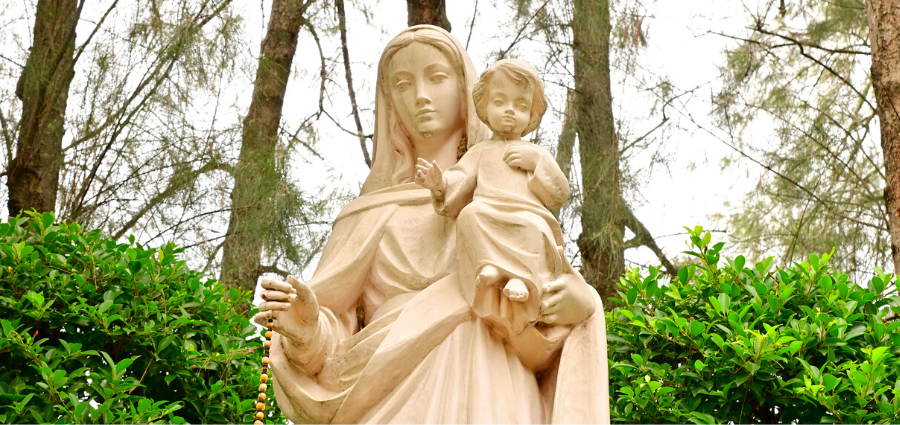
pray the rosary | about the rosary
The Rosary has had a long history and has gone through many stages of development. The use of prayer beads precedes the time of Christ. Hindus used them to help keep track of prayers said throughout the day. In the Christian tradition, early monastic orders would pray the 150 Psalms daily.
At first, they would use 150 pebbles in a small pouch to keep track. This practice later developed into a string with 150 knots and a rope with 150 wooden beads. Members of the laity who did not necessarily know the psalms by heart wanted a comparable version of this practice, so the tradition of praying 150 "Our Fathers" each day was born. A similar string of beads was also used to keep track of this. In time, the "angelic salutation" of Gabriel was added before each "Our Father" — "Hail Mary, full of grace, the Lord is with you." Later on, Elizabeth's greeting was added to this: "Blessed are you among women." Still, later, the prayer of "Holy Mary, Mother of God, pray for us sinners now and at the hour of our death" was added, and the "Hail Mary" as we know it was developed.
Meanwhile, in 1214, Mary appeared to St. Dominic and encouraged him to spread devotion to the Rosary. She promised him that if he did so, he would successfully convert the Albigensians and that the Religious Order he founded would prosper. He spent the rest of his life encouraging others to pray the Rosary and founded a Rosary Confraternity to aid in this task. One hundred years later, Blessed Alan de la Roche picked up where Dominic's work had ended. He divided the Rosary into 10 "Hail Mary" decades preceded by the "Our Father." In the 15th century, the mysteries of the Rosary were assigned to each of the decades. This addition allowed people to reflect on Scripture while offering this meditative prayer. In 1917, Our Lady appeared to three young shepherd children in Fatima, Portugal. She declared herself to be "Our Lady of the Rosary" and repeatedly urged the children to recite the Rosary daily.
In more recent times, Pope John XXIII taught that the Rosary must have a threefold purpose: "mystical contemplation, intimate reflection, and pious intention." On October 16, 2002, Pope John Paul II added a new set of five mysteries to the Rosary. Known as the "Luminous Mysteries" or "The Mysteries of Light," they focus on Jesus' public ministry. In his apostolic letter "The Rosary of the Virgin Mary," he wrote, "The Rosary, though clearly Marian in character, is at a heart a Christ-centered prayer. It has all the depth of the gospel message in its entirety. It is an echo of the prayer of Mary, her perennial Magnificat for the work of the redemptive Incarnation which began in her virginal womb."
Pope St. Pius V established the feast of Our Lady of the Rosary (October 7) in 1573 to thank God for the victory of Christians over the Turks at Lepanto, a victory attributed to the praying of the Rosary. Pope Clement XI expanded the feast to the universal Church in 1716. Pope Pius XII officially established the dedication of the entire month to this devotion in 1884. While devotion to this prayer form waned a bit in the years immediately after Vatican II, interest in this long-practiced devotion is experiencing a resurgence as the faithful rediscover the beauty and spiritual benefit of this meditative practice. The name "rosary" comes from the Latin "rosarium," which means "rose garden."
A Rosary is widely considered a gift of roses to Our Blessed Mother in heaven, and an excellent way for families to come together in prayer.
Patrice Fagnant-MacArthur has a master’s degree in applied theology and is the author of The Power of Forgiveness, Our Lady of La Salette: A Mother Weeps for Her Children, and The Life and Lessons of St. Zelie Martin. A mother of three, she is the editor of TodaysCatholicHomeschooling.com as well as a freelance writer and editor.
